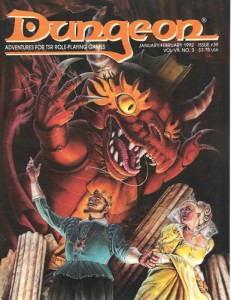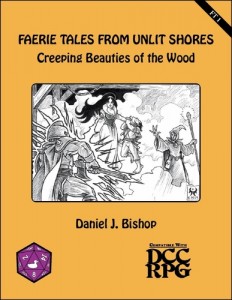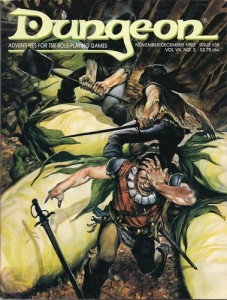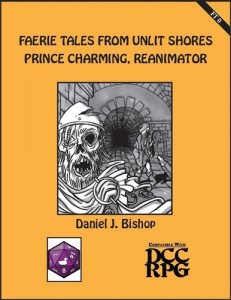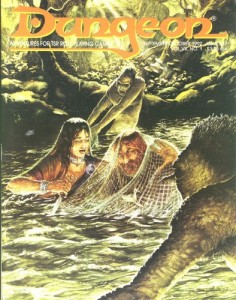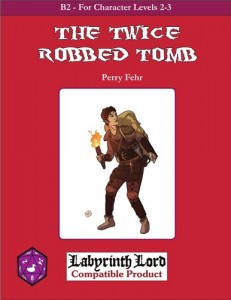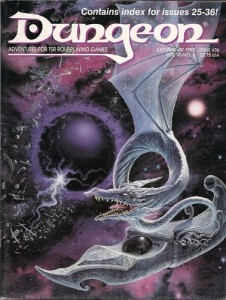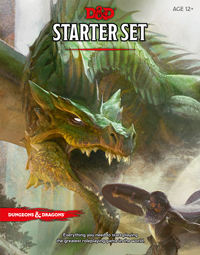
EDIT: For you new readers, I have VERY high standards. This adventure is one of the best to be published by WOTC in a LOOONNNNGGGGG time.
Are you seriously reading this review in order to figure out if you should buy 5e? Our long nightmare is over … D&D is back! Go buy it, play it, and enjoy!
The first segment of the adventure puts DMs through the basics of asking for checks and saving throws, as the characters venture into a goblin lair on a rescue mission. Once the adventurers have dealt with the goblins, they have free reign to explore the region around the village of Phandalin. Three more dungeons and five other adventure locations provide novice DMs with plenty of material to keep a campaign going for months.
This is the beginning adventure(s) from the D&D 5e starter set. D&D finally has it’s head (mostly) out of its ass in a set of adventures that provides a framework for the players to have fun in. This is not the “D&D turned up to 11” of some of the recent editions, but rather a solid 7, 8, or 9 that keeps delivering over and over and over again. It provides a pretty solid foundation from which a DM can build on, with a rough outline of action and some interesting, but not set-piece, encounters. It suffers more than little on the mechanistic way magic items are treated and in the lack of evocative descriptions … especially for monsters.Overall though this is a VERY solid adventure in the high-C/Low-B “Bryce has unrealistically high expectations” grading scale … even if “months of material” may be stretching things.
The adventure comes in four parts. The first is a small ambush and cave lair. It serves mainly as a hook. The second is a town. This serves mostly as home base with several quests that can be picked up. The third is an exploration of the region, driving by the quests in town, where several clues can be picked up as to … the fourth part: the Evil Bad Guy’s Lair. The adventure is written in a progressive rules learning style, with more rules presented inline with the adventure near the beginning and things flowing little more streamlined near the end. Embedded in the adventure is advice for the DM, most of whig is pretty decent. Things like “ham It up” and ‘don’t go on too long” and “let the players do what they want.”
This seems like a good time to cover something important. The starter set is intended for new players. New players will learn how to play D&D from this set. I believe VERY strongly that the tenor & tone of of an RPG derives mostly from the published adventures. The published adventure is what the masses will think is ‘normal’ or ‘how the game is played’ and thus the published adventure from the company has a vast opportunity to influence the direction of the game. If it involves 3 straight up combat encounters,no roleplaying, and a skill challenge, then people are going to play that way at home, published adventure or no. The RPGA and con games will do the same thing. If all you publish are dungeon crawls then people will think that’s what the game is about and play that way. These beginning adventures are important. Balanced against this is the very real fact that this is, essentially, a programmed exploration of the rules set for people who have never played before. Some things are going to be a bit clunky as the adventure holds your hand. I usually don’t give a shit, an adventure has to stand on its own merits. Im going to try and walk a finer line with this one, attempting to recognize and be generally ok with the hand-holding while still attempting to uphold standards of good adventure writing.
Part 1 – The most generic hook possible: you’re caravan guards
This was my introduction to this adventure. A cute little one column background that an entirely appropriate length followed by a couple of sentences explaining that the party are caravan guards. That hook was NOT a strong start. It recalls every crappy adventure ever written in which there was a throw-away line about the party being caravan guards. No details. You’re guards. Move along. Caravan guard is a classic trope. The classics got to be classics for a reason: when well done they are REALLY good. I recall an adventure in Dungeon Magazine in which the party were caravan guards. It included a short section that was a nice little realistic depiction of the duties during the day and what goes on the campfire at night and gave the (three?) merchants a personality and some wares to sell and they interacted with the PC’s, all described in a section that wasn’t overly long and used some strongly evocative language. This ain’t that. The whole purpose of the caravan guard thing is to put you on the road to the frontier town that will serve as the parties base … so you can be ambushed. Lame. LAME LAME LAME. Now, it turns, out, that the pre-gens all have some little hooks on their character sheets that motivate them to get involved in the adventure. Those hooks are pretty decent. The thief was part of the gang in town, they were framed and set up and now want revenge. There’s a do-gooder, a guy who has an ancestral tie to the land, and so on. These are pretty well done and should serve as some strong motivations to get to the town. The pre-text then, the caravan guard duty, is just the surrounding glue that motivates them to journey together at the same time. It is at this point I should disclose that I have DEEP scars about character motivations. I’ve seen them used to justify some pretty crappy PC behavior, all on the grounds of “that’s what my character would do.” This includes a player having their character sit out the ENTIRE adventure because ether character wouldn’t do that. I’m VERY suspicious of this stuff. In this case the written text seems to work well with the glue of the hook … EXCEPT FOR THE ELEPHANT, which I’ll talk about later.
So, goblins ambush you on the road. You chase them back to a cave, kill everything, take their stuff, rescue a dude, and continue on the way back to town, ending part 1. The purpose here is really to bind you to the town. There are looted caravan goods to return to the rightful owners. The dude to be rescued is moderately important in the town. There are other clues present that can bind you to the town and kick off that next part of the adventure. It’s very well constructed from this standpoint … EXCEPT FOR THE ELEPHANT. Things link together without shoving you down a railroad. It’s presented as things for you to explore, and secrets for you to uncover instead of GO TO POINT A AND THEN POINT B AND THEN SKILL CHALLENGE AND THEN POINT C YOU WIN YEAH YOU. The encounters themselves try very hard. They mostly succeed. The ambush has a couple of dead horses blocking the road, with black-feathered arrows sticking out of them. Nice! The goblins in the cave lair have some wolves chained up, with the wolves straining against their chains. And a goblin on a bridge overhead keeping lookout. Have a light?! He signals to have some flood gates broken open to flood out the streamed you are coming up! One of the goblins will talk to you if you try, and bargain with you so you’ll go get rid of the guy bullying the tribe. There are a lot of nice little things to ensure that every encounter feels like a unique challenge. There are notes about what the goblins can tell you if captured/charmed and you can talk and bargain with one of the goblins! In a completely sickish move the goblins betrays you … which sends TOTALLY the wrong message. Why ever bargain with a monster if they all betray you? Just kill them and move on. Is that really the behavior you want to encourage? Yeah, I’m sure it’s a deceitful little creature but … it’s not stupid. I’m sick of every monster you can talk to betraying their end of the deal.
Part 2: Welcome to Adventurehookville. Population: YOU
At some point you are going to make it to the small frontier town that will serve as your base. There you will be herded towards “the best inn in town.” Once there you’ll get an opportunity to be exposed to several rumors, which will lead to many of the other seven or eight locations in town. From there you can pick up quite a few rumors and/or quests of things to investigate or expire. Some are tasks and some are things the party might be interested in. It’s good mix and the locations do a better than average job of being connected and interrelated. That’s not exactly high praise since the vast majority don’t do anything at all like this, but, they tried and the effort shows. In particular, the adventure gives a brief summary of the major NPC’s, where they hang out, and what their objectives/quests are. That’s done in just a sentence or so each. I find these sorts of references INVALUABLE. Read through the adventure once and then use the summary to trigger your memory of what you read earlier. More adventures need to do this. In addition, the rumors from the main inn lead to other locations, which sometimes lead to other locations. That sort of interrelationship is a nice touch. The major NPC’s have some small personalities and many of them, besides keying the characters to quests, can offer membership in a secret societies of sone sort of another. There’s also some brief mentions of the vibe of the town. It’s described in terms that make you think of the ‘camp’/town from the Deadwood series. IE: a western frontier town. It doesn’t explicitly give you that character or vibe, it just says it has a frontier like character with prospectors, etc hanging out in town. I wish it had gone a little more in to some detail of some of those terrific Deadwood street scenes: the hawkers, characters, etc. The whole town is quite light on descriptive and evocative language/scenes outside of the core locations (and, I will assert later, IN the core locations as well.) Finally the town is lacking on interpersonal relationships. I would have liked to see a web of personal relationships between the various people living in town. What does the guild master think of the innkeeper, or the innkeeper of the trading company, or the trading company of the guild master … that sort of thing. These sorts of social environments THRIVE on the web of relationships between the parties. This will help make the town seem alive and to exist outside of the interactions of the party. “Welcome to Mortistown”, a zombie sourcebook for a town, did this masterfully. It suggested reactions, gave the starting positions, and suggested a timeline based on the motivations on the motivations of the NPC’s. I’m not saying that a town supplement/section needs to go to the lengths Mortistown did, but it’s a good example to learn from.
There’s a major encounter in town that could have been done much better. There’s a gang in town that kind of controls things and is bullying/extorting people. The NPC’s in the adventure provide some vague references to them being neer-do-wells, but there’s not much beyond that. The major introduction to them is going to be a fight between them and the party. That’s pretty poor. The gang needed more of a build-up. SHOW, don’t TELL. Show us scenes of their petty evil … evil not enough to deserve a sword-thrust to the gut but more than enough to tell us they are unsavory. You have to build up these sorts of things. Their hideout is under an old manor home and the exploration of that ‘dungeon’ is one of the major town events. It kind of feels … I don’t know … lost? Tacked on? The bandits/gang don’t really react to intrusions very well. They all sit in their rooms and wait to be hacked down by the party. Intelligent creatures should have some sort of order of battle for their lair. How do they react? Who calls who for reinforcements? The dungeon is a small one but has a couple of nice physical features, like a crevasse and a couple of other interesting features. A few of the rooms are mostly empty while most of the rooms have something going on in them. Undead. Slave pens. But it all just seems a little flat.
Part 3: Hex Crawl
Most of those rumors and quietists from Adventurehookville can be followed up on in the small hex crawl presented. There are six to eight locations scattered throughout the region. One is medium-sized, one large, and the others smaller single-encounter type locations. They are all within about a 2.5 day circle of travel. This allows for … Wandering Monsters! Once a day and once a night you check for wanderers on a d20 with a 17+ indicating a monster. I’m not sure about this working. Traditionally these served the role of sucking down the party resources but I’m not sure how effective that is when all your HP come back after a single nights rest. I’m going to have to play to get a better view of this but it seems to me, on first impression, that someone threw in wanderers because they were traditional. Given the new rules on healing I suspect there needs to be some work done to make the wanderers “fit” again with a decent purpose. The game is no longer about treasure, so that’s not it. You can heal in a single night, so that’s night it. So if the wanderers are no longer a ‘risk’ then what purpose to do they service? IDK. I will say that the wanderers are kind of lame. Only a grow of hobgoblins has any flavor to them. I would have liked to have seen a little more flavor, or the monsters doing something instead of the generic “they attack!”
I really liked the various locations though. You can talk to monsters and they have a decent mix of The Fantastic present. I want to mention a couple of points in particular that I liked. The first location is with a banshee. It talks to you and serves as a kind of oracle. That’s pretty sweet! It described near a ruined town/village that a major east-west trail runs through. Just the few words they use on the town paints a wonderful picture of some abandoned post-apoc-like setting with an important road still running through it. This whole thing was done really well. There’s another location with someone that is evil … or at least is known as the villain in most previous Forgotten Realms adventures: a red wizard. In this location he’s not really interested in the party and isn’t really doing anything particularly evil. it’s a great example of the party encountering someone or something that can help them … if you’re willing to pay the cost. These sorts of set up are SOOOOO much more interesting than a pure “THEY PUKE EVIL AND ATTACK!” encounters. Look, you can always hack the dude down later, because he’s evil or because he’s got some nice loot, but, first, TALK to them. There’s another location, the medium one in size that I referred to earlier, that is another ruined little village with nine or ten little locations to explore. And there’s a dragon! And it’s in an interesting location! Alas, the dragon is given no personality AT ALL and the location i.e. Barely described. I understand and support a terse style, but some suggesting for dragon-fighting in a ruined tower would have been great. Collapsing floors, stairs, loose timbers, rubble, etc. This would have been a great place for a little more detail on the encounter. The dragon should have had a personality as well, for exactly the same reasons cited above. Additionally … ITS A DRAGON. It’s your FIRST dragon. It should be impressive and full of life and personality and talk. Smaug is SO much more interesting because it talks to Bilbo. The final location, the major one, is a small ruin with fifteen or so locations. The entryway is one of the only interesting parts of this. A little set piece if you come through the front door, the rest of the site is pretty much just “room with a monster, room without a monster, room with a monster.” At best you can sneak around or maybe try to bluff through some of them. I guess I was expecting more … weirdness? Instead it’s more like a little tactical assault. Except, again, there’s no order of battle. The notes on who reacts to assaults and how are essentially nonexistent once you get past the gate guards. That’s quite disappointing, especially given the layout of the site. There’s a lot of doors and rubble and hallways to ambush and be ambushed and sneak past and so on. There are some nice notes about some monsters showing up back home at the end, after he major fights are over, and how the party can deal with them. That’s a nice little touch I appreciated. It makes it seem like the place is alive and exists as place instead of everyone just coming out of stasis once a PC opens a door.
Part 4: Dungeon
Nope, not gonna spoil this. Decent map, nice variety of features. A couple of good descriptions. Some interesting encounters. Overall, not enough to play with. There needs to be more weird and more stuff to fool around with. There seems to be a lot more risk than reward. This might be an apt summary for most post-“gold as XP” D&D’s. Why do this? I will note that the Evil Bad Guy, in this dungeon, doesn’t EXACTLY suffer from Lareth syndrome. He’s referred to in several places by several people before you hit the dungeon. What you don’t get, though, is a sense that the dude is E V I L. Again, this goes to the “Show, don’t Tell” stuff. He’s abstract, you know he’s there but the evidence of his evil acts is … almost nonexistent? Sure, he got some goblins to raid some stuff. Yawn. Where’s the beef? I don’t need gore but you do need to set the dude up better. Make the PLAYERS want to track him down instead of forcing them to make their CHARACTERS go after him “because it’s the right thing to do.”
Nice time to transition. The elephant is the moral worldview enforced by the designers. In most of the adventure you are expected to go do something Because It’s the Right Thing To Do. Chase the goblins? Clean out the lair? Return the stolen trade goods? Follow up on almost all of the hooks? BECAUSE … GOOD! In fact, for the trade goods, no other option is presented. The trade goods get you a reward for returning them but nowhere is the value otherwise mentioned, or an literate hook if you come in to town clearly selling something looted from a caravan. That sort of view is present over and over again in the adventure. Options and paths of play are just shut down. In the case of the trade goods, it could have been an excellent option to infiltrate the local bandit gang, or use in other creative ways. But none of this exists because the designer has decided you can’t do that. The designer should EMPOWER and ASSIST the DM, not enforce their plot or views upon them. Brand new players are often, in my experience, the MOST creative and providing the framework to support that creativity IS the designers job.
The monsters in this adventure suck. There should be wonder and fear when you encounter something. Do you say “you see three ghouls.”? No, of course not. You describe them and what they are doing. You leave the party guessing. What kind of thing is that? What does it do? What do they want? Can it kill us? That’s the kind of monsters encounter I want to see, ones that encourages the players to soil themselves over THE OTHER. Instead we get “you see three goblins” or something similar. Uncool WOTC. The monster descriptions are boring as hell, with almost no attention paid to what the DM actually needs: what the PC’s EXPERIENCE when they meet them. Stink like the grave? Matted patchy fur? None of that is present. And the monsters attacks are generally disassociated. Bugbears get a surprise damage bonus that is presented completely mechanically: if you get surprise you do 2d8 more. Yeah. Mechanics. How about something like “Their dark fur allows them to blend in to shadows well, giving them a plus 2d6 to damage as they leap out in the surprise round.” Again, you are teaching new players how to play and you just taught an entire generation of DM’s to say “you see two gricks.” Bull. Shit. That’s not the D&D I want to play. That a board game. Deliver the wonder! It’s not that hard. We don’t need a page, or a column, or a paragraph. Just one sentence. The free Dragonsfoot “Where the fallen jarls sleep” has a GREAT description of the undead, one of the best ever.
In a similar vein, the magical items generally are none too great. They tend to be very mechanical. ‘+1 sword, deals max damage to plant creatures.” Ok, That’s not as awful as just a +1 sword, and they generally do present a little backstory/history for each item. That’s very nice; they don’t go on for too long but they do provide a … grounding? For the characters to know what it is they are carrying and add a nice bit of the non-generic. The issue is that the items are all grounded in the mechanics. Pluses, maximums, additions, rerolls … it’s all very board gamey. In a game where you can ANYTHING, literally ANYTHING, you give us an item that gives +1 to defense? Ok, that’s a little hyperbolic, but the mechanical way magic is treated is much closer to 4e than it is to OD&D or T&T. Gems that you swallow and turn you in a beaver? The gem in the first level of the darkness beneath that shoots out flames? GREAT items without a whiff of the generic or mechanical. Effects are described instead of mechanics. It’s like someone is TERRIFIED of the ambiguity that this sort of non-mechanical thing may introduce. Another word for the DM is Judge. Let the Judge handle the ambiguity … that why they exist! There is a GREAT magic item in the hex crawl, a little statue that gives everyone an augury once. That’s a nice little touch and exactly the sort of magic item I’m looking for. It’s NOT straight out of a book and it oozes wonder and mystery. THAT’S what magic items should do.
Finally, I want to cover the user of descriptive language. There’s not a lot. The encounters and place just don’t seem to pop. They are generally interesting enough, like the goblin on the rope bridge or the flood they release or the wolves on their chains, for example. But they don’t don’t pop. They don’t do a very good job of springing to life in your mind. I think it’s because of the lack of descriptive language. While reading through the adventure I was struck by the goblin lair seeming a bit generic … but then when I looked back over it it was clear that the situations were interesting. But they didn’t stay with you. They didn’t seem … exciting? And I think what I mean by this is that the encounter didn’t get ME, the DM, excited about running it. In the town section this really stood out. It was either in the rumors section or somewhere else when it hit me. There were nouns and verbs but the adjectives and adverbs were not used very well. “The farmers wife tells you … “ instead of the “the prim farmers wife tells you …” There’s was nothing of the FAVLOR being communicated. Floods should be raging torrents. The NOC’s should have personalities, or flavors, to assist the DM and bring the encounter to life in your mind. Farmers Wife leaves a lot open. Granny, prim, biddy, lusty, stoic, proper … all of those give you, the DM, something to work with. They conjure a NON-generic image in your mind that you can build on. There’s WAY not enough of this in the adventure. Hence the kind of “generic’ vibe. Generic goblin. Generic cave. Generic wolves. This lack of descriptive material, just a word or two really, is a reall killer.
You don’t get it both ways. You can’t claim to be a Starter Set and then not include GREAT magic items and monster descriptions. You gotta make this thing pop. You gotta make people want more More MORE. The monsters, magic items, and descriptions don’t really do that. In the end you get a serviceable adventure/set of adventures. They are nicely connected with a home base that is better than usual. This is a decent adventure, it delivers over and over again in a non-sucky way. In an above average way. But it doesn’t hit the highs, consistently, that the best products do. I’m disappointed in that. I wanted this to knock your socks off. It’s big. It’s long. Both of those are great. But the quality isn’t what I was hoping for. But, in spite of the Starter Set adventure not being the second-coming of Dave Bowman or Calithena, it does put D&D back on SOLID ground again. I’d be happy to run this. I fucking love D&D, and D&D is now back!
Now for some self-promotion:
Did you seriously just read all of that? Wow. You should be playing D&D instead. If you’re in/near Indianapolis then you should check out the Indy Gaming meetup. My wife runs the group. We’re running an all-day play through of the starter set on July 19th. RSVP and come along!
Want to celebrate the return of D&D by being a butthead? Drop me a line! We’re having a bonfire to celebrate the evening of July 11th. Feel free to bring the old edition; we’ll need fuel for the fire.
This is available on Amazon.
https://www.amazon.com/Dungeons-Dragons-Starter-Wizards-Team/dp/0786965592/ref=sr_1_1?keywords=phandelver&qid=1550494610&s=gateway&sr=8-1&_encoding=UTF8&tag=tenfootpole-20&linkCode=ur2&linkId=cfc3967b9a107b31429d26273b785565&camp=1789&creative=9325


